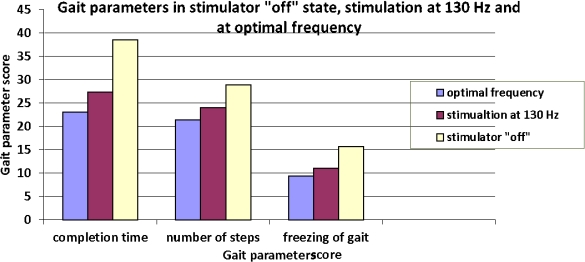Session Information
Date: Monday, June 20, 2016
Session Title: Surgical therapy: Parkinson's disease
Session Time: 12:30pm-2:00pm
Location: Exhibit Hall located in Hall B, Level 2
Objective: To study various frequency settings and to identify the optimal frequency of bilateral subthalamic nuclei deep brain stimulation (DBS) for improvement in gait in Parkinson’s disease(PD) patients.
Background: Bilateral subthalamic nuclei DBS improves most motor symptoms with a commonly used frequency of 130 Hz. Severe gait disturbances and freezing episodes often appear in advanced Parkinson’s disease (PD) and may worsen or may be unresponsive to standard frequency of stimulation. Lower frequency in DBS have been found to be more beneficial for gait.
Methods: This is a open label interventional study. Ethical committee approval was taken and informed written consent were taken from all patients. 20 patients who underwent STN-DBS atleast 1 year prior to the study with meaningful response after DBS (improvement in UPDRSIII “off” score by atleast 5 points) with complaints of gait problems were included in the study,. Patients with surgical complications and unable to walk post operatively were excluded. Patients were assessed during medication ‘ON’ state. Every patient was assessed using 4 frequency settings i.e., 60Hz, 90 Hz, 130 Hz, 180Hz and device ”off’ state. Gait was assessed using The Stand–Walk–Sit (SWS) and Freezing of gait scoring. Best response was calculated based on improvement on SWS score and FOG score was used to confirm the improvement.
Results: 20 post DBS patients were studied, out of which 6 were female. Average mean age was 55.1 ±10.2 years, mean disease duration disease was 13.97 ± 6.87 years. Mean pre DBS UPDRS III motor score in ‘ON’/ ‘OFF’ was 12 ± 4.5) /51 ±-15. There was marked variation in the response to the stimulation frequencies. We determined the frequency, which lead to the best response in each patient. FOG test also demonstrated significant improvement with the same settings  .Gait was best with 180 Hz in 8 (40%), 90 Hz in 7 (35%), 60 Hz in 3 (15%), and 130 Hz in 2 (10%). There was no statistical significant difference in demographic details, pre-operative UPDRS III scores, duration of disease and amplitude settings of patients with best response at each frequency.
.Gait was best with 180 Hz in 8 (40%), 90 Hz in 7 (35%), 60 Hz in 3 (15%), and 130 Hz in 2 (10%). There was no statistical significant difference in demographic details, pre-operative UPDRS III scores, duration of disease and amplitude settings of patients with best response at each frequency.
Conclusions: Optimization of frequency setting for each patient can improve gait and each patient may have a different optimal frequency. Both higher and lower frequencies may be beneficial and every PD patient with gait abnormality should be evaluated for best frequency.
To cite this abstract in AMA style:
R.M. Kandadai, V.V.P. Kagita, S.A. Jabeen, A.K. Puligopu, M.A. Kanikannan, R. Borgohain. Effect of frequency modulation on freezing of gait in PD patients after bilateral STN DBS [abstract]. Mov Disord. 2016; 31 (suppl 2). https://www.mdsabstracts.org/abstract/effect-of-frequency-modulation-on-freezing-of-gait-in-pd-patients-after-bilateral-stn-dbs/. Accessed April 25, 2025.« Back to 2016 International Congress
MDS Abstracts - https://www.mdsabstracts.org/abstract/effect-of-frequency-modulation-on-freezing-of-gait-in-pd-patients-after-bilateral-stn-dbs/
